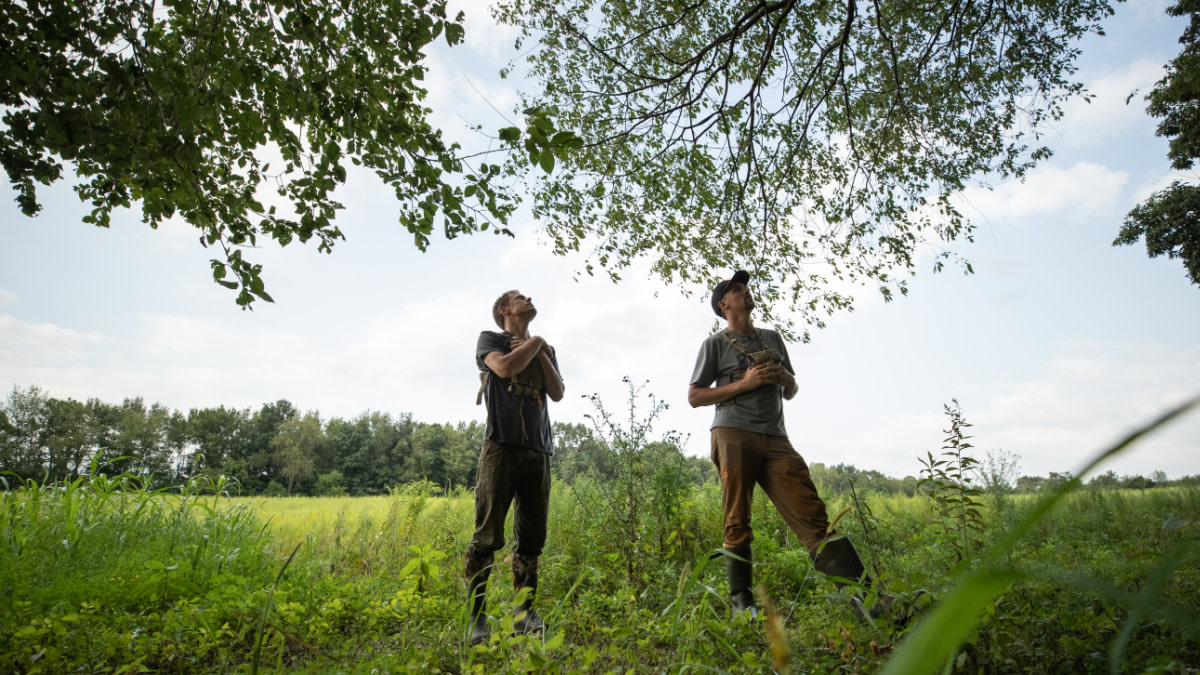
Out of all the seasons, I do the least amount of deer scouting during the summer. It’s not that scouting during the summer isn’t practical, but I end up prioritizing other things in life because I know that I want to get as much hunting in during the fall as possible.
With that said, I’m still utilizing trail cameras and doing other essential tasks in the woods like picking the perfect tree stand or saddle hunting location. There are a few reasons I like to pick my trees to hunt out of during the summer. First, I’m not worried about putting pressure on the deer. Secondly, you can clearly see the worst-case scenarios of foliage and cover obstructing shooting lanes.
Don’t Worry About Summer Trail Camera Photos
When thinking about picking the perfect tree stand location, you must first understand how to not pick a bad one. The biggest mistake I see other hunters make is getting a bunch of trail camera photos of mature bucks during the summer and choosing a tree to hunt based on that intel.
You can learn a lot from summer trail camera photos, but more so that a buck is in the “area” rather than a specific “location.” Bucks are in bachelor groups during the summer, which could mean a particular deer may live in the area or he may not.
Also, food sources, cover, water, and other variables will change between then and the opening day of deer season. If you have an early September opener, this could change my perspective, but it will change drastically once the velvet sheds for most of us.
Consider the Time of the Year
Picking a tree will be strongly influenced by when you plan on hunting the area. If a spot is set up for an early October hunt, it will look different from a November rut location. The foliage is one aspect, but you must also consider other factors such as bedding, food, water, cover, and hunting pressure.
Let’s say you find a rut funnel based on terrain and adjacent doe bedding. First, spend some time in that location just soaking in the area. When I find a place that I think would be good, I might take 30 to 45 minutes to pick the perfect spot. Next, I’ll consider the historical prevailing wind for the location, any potential thermal interactions, time of day that you would expect to see deer movement, access to and from the tree, tree cover, and shoot-ability to nearby trails.
When hunting hill country during the rut, I like to pick trees on the upward side of the trail due to daytime thermals rising when bucks would be checking those does that have bedded down for the day. During early-season morning buck bedding setups, I like to be below the trail with consideration for downward pulling thermals at first light when the buck is likely returning to his bed.
Hunting from a saddle has allowed me to get in just about any tree and has opened up many possibilities that I didn’t otherwise have hunting from a tree stand. I want to be in the right location, more so than the “perfect” tree.
Understanding Foliage Types
The most challenging thing about picking a tree during the summer is that the woods are thicker and denser than any other time of year. There are a couple of ways of navigating this. First, this shows you the worst-case scenario for shooting lanes and the best-case scenario for cover.
This is the time to cut shooting lanes if you can. The other consideration is that if you plan to hunt the location in November or December, the foliage will look much different, and most of the trees will have lost their leaves by that point. You can assume which trees will still hold leaves and which ones will not, based on your region and the tree type.
In Pennsylvania, it’s known that beech leaves will stay on the trees throughout most, if not all, of the year, and oak trees drop their leaves later than the other hardwood trees. Conifer trees and other species such as mountain laurel and rhododendron will always carry foliage.
Knowing these simple botanical facts will help you visualize what the woods will look like during a particular time of year. Foliage isn’t only a factor in your cover but also plays into deer behavior. Bucks want to move where they feel safe, and as the season progresses, these areas shrink smaller and smaller.
See It For Yourself
The last step is to bring your stand or saddle platform and sticks with you to climb into the tree that you choose to get a first-person visual from hunting height. This isn’t the most favorable thing to do during the hot and humid summer months, but it is a highly effective way to see if the spot is as good as you thought.
Things look a lot different from the ground to the tree. Don’t rush finding the perfect tree stand location; think through each step purposefully. Every detail could make the difference in filling your tag in the fall!





